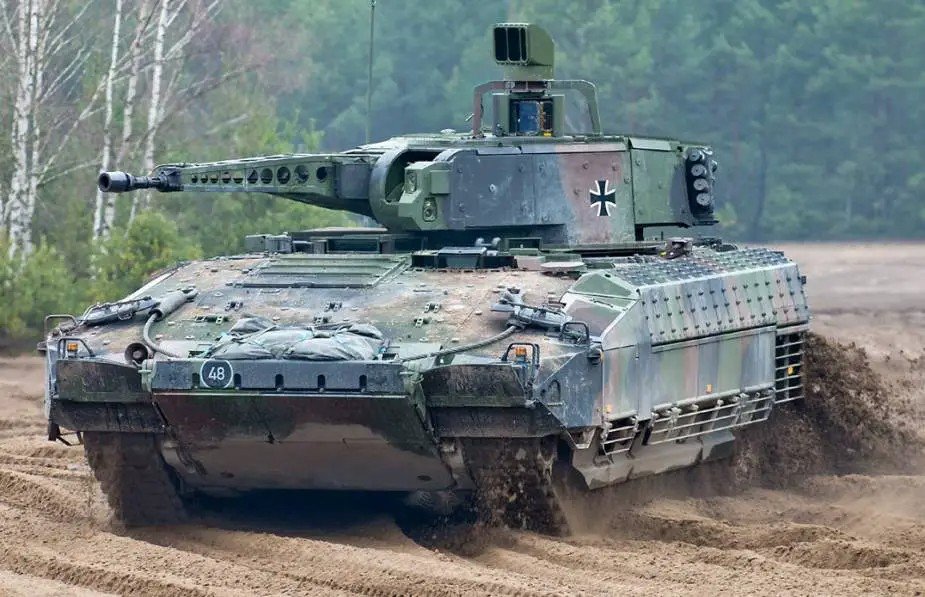
Bundeswehr German army orders 50 more Puma IFV infantry fighting vehicles
Germany’s two top military vehicle makers, Krauss-Maffei Wegmann (KMW) and Rheinmetall, have been awarded an order to build a further 50 Puma infantry fighting vehicles. Including value-added tax, the total value of the order comes to €1.087 billion. Of this amount, €574 million will go to KMW and €501 million to Rheinmetall Landsysteme GmbH, both of which are serving as subcontractors in the project.
 A contract to this effect has now been issued by Germany’s Federal Office for Bundeswehr Equipment, Information Technology and In-Service Support (BAAINBw) in Koblenz. The general contractor is Projekt System & Management GmbH (PSM), a joint venture of KMW and Rheinmetall. A framework agreement was signed enabling the subsequent call-off of further Puma IFVs.
A contract to this effect has now been issued by Germany’s Federal Office for Bundeswehr Equipment, Information Technology and In-Service Support (BAAINBw) in Koblenz. The general contractor is Projekt System & Management GmbH (PSM), a joint venture of KMW and Rheinmetall. A framework agreement was signed enabling the subsequent call-off of further Puma IFVs.
In addition to the 50 Pumas, the order encompasses spare part packages and special toolsets as well as 8 MELLS flight-phase simulators. Furthermore, an option exists for additional driver training vehicles and the integration of a turret-independent secondary weapon system, or TSWA. Delivery is set to start in December 2025 and be complete by the beginning of 2027.
The Puma IFV (Schützenpanzer, or short SPz) was designed to replace the aging Marder 1A3 IFVs currently in service with the German Army. Production of the first batch of 350 vehicles began in 2010 and was completed in August 2021. A second batch of 229 Pumas received funding. Mass production began on 6 July 2009. The companies responsible for this project are Krauss-Maffei Wegmann and Rheinmetall Landsysteme, which created a joint venture, Projekt System Management GmbH (PSM).
Equipped with a powerful MTU 10V892 diesel engine, the Puma IFV boasts exceptional mobility both on and off-road. It can achieve a maximum speed of around 70 km/h (43 mph) and has a range of approximately 600 km (370 miles).
The Puma, while externally not very different from existing IFVs, incorporates a number of advances and state-of-the-art technologies. The most obvious of these is the incorporated ability to flexibly mount different armor: the Puma IFV has a modular add-on armor that allows for customization according to mission requirements, ensuring adaptability in different operational environments. Another feature is the compact, one-piece crew cabin that enables direct crew interaction (“face-to-face”; like replacing the driver or gunner in case of a medical emergency) and minimizes the protected volume. The cabin is air-conditioned, NBC-proof with internal nuclear and chemical sensors and has a fire-suppressing system using non-toxic agents. The engine compartment has its own fire-extinguishing system. The only compromise of the otherwise nearly cuboid cabin is the driver station, located in a protrusion in front of the gunner, in front of the turret.
One measure to achieve the one-piece cabin is the use of an unmanned, double-asymmetrical turret: while slightly off-center turrets are common in IFVs, the Puma’s turret is on the left-hand side of the vehicle, while the main cannon is mounted on the right side of the turret and thus on the middle axis of the hull when the turret is in the forward position. The Puma IFV is armed with a fully-stabilized Rheinmetall 30mm Mk30-2/ABM autocannon, which offers high accuracy and a rapid rate of fire.. Additionally, the IFV is equipped with a coaxial 7.62mm machine gun and can carry up to 200 rounds of 30mm ammunition and 2,000 rounds of 7.62mm ammunition.
The Puma IFV incorporates advanced battlefield management systems, thermal imaging and night vision capabilities, as well as NBC (Nuclear, Biological, and Chemical) protection systems.
The whole combat-ready vehicle in its base configuration is air transportable in the Airbus A400M tactical airlifter.
Only recently, in February 2023, BAAINBw awarded an order for the comprehensive modernization of 143 Puma IFVs in the Bundeswehr inventory that had not yet been upgraded to the latest S1 standard. The upgrade, to be complete in 2029, includes among other things the integration of high-resolution day- and night-capable camera systems, the MELLS multirole lightweight guided missile system as well as the integration of digital radio equipment. When they leave the factory, the fifty newly ordered vehicles will also conform to the latest S1 standard.


